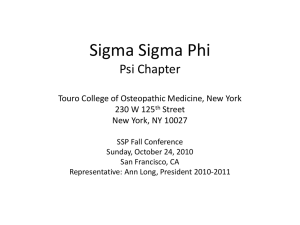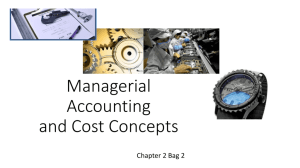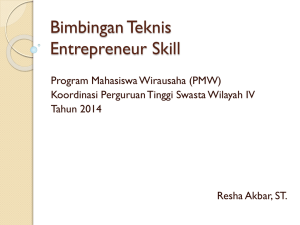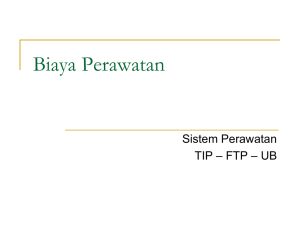Metodelogi Six Sigma Pertemuan 10a
advertisement
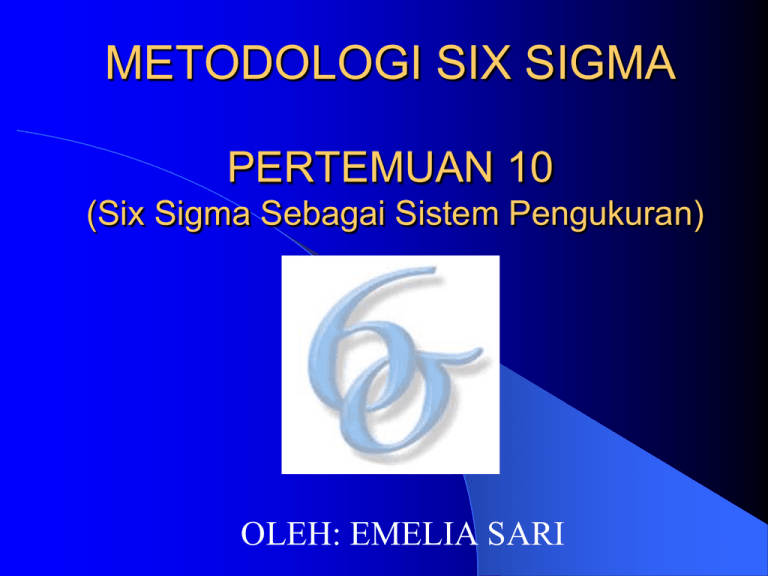
METODOLOGI SIX SIGMA PERTEMUAN 10 (Six Sigma Sebagai Sistem Pengukuran) OLEH: EMELIA SARI Fokus Six Sigma Pengurangan Cycle Time Pengurangan Jumlah Produk Cacat Kepuasan Pelanggan 2 Arti Penting Six Sigma Six Sigma sebagai filosofi manajemen Six Sigma sebagai sistem pengukuran Six Sigma Sebagai Filosofi Manajemen Six Sigma merupakan kegiatan yang dilakukan oleh semua anggota perusahaan yang menjadi budaya, dan sesuai dengan visi dan misi perusahaan, dengan tujuan meningkatkan efisiensi proses bisnis dan memuaskan pelanggan sehingga meningkatkan nilai perusahaan. Six Sigma Sebagai Sistem Pengukuran Six Sigma diterapkan untuk memperkecil variasi. Six Sigma sebagai satuan pengukuran menggunakan Defect per Million Opportunities (DPMO) sebagai satuan pengukuran. PPM pada umumnya menggambarkan jumlah yang tidak memenuhi syarat (defective). Suatu bagian yang tidak memenuhi syarat (defective) mungkin mengandung beberapa cacat (defects) Six Sigma Sebagai Sistem Pengukuran (2) DPMO merupakan ukuran yang baik bagi kualitas produk ataupun proses sebab berkorelasi langsung dengan cacat, biaya dan waktu yang terbuang. Selain DPMO, six sigma juga menggunakan satuan pengukuran berupa persentase keberhasilan (yield percent). Yield percent: persentase produk yang bebas defect. Cara Menghitung DPMO Hitung Defect per Unit (DPU), dimana: DPU = Total Kerusakan : Total Produksi Hitung DPMO dengan terlebih dahulu menentukan probabilitas jumlah kerusakan DPMO = (DPU x 1 juta) : Probabilitas kerusakan Cost of Poor Quality One of the differences between a Six Sigma quality improvement approach and many prior quality programs is the emphasis on financial returns. Because Six Sigma is a business initiative rather than a quality initiative it makes sense that financial returns of Six Sigma projects are measured COQ and COPQ The cost of quality (COQ) refers to the costs associated with preventing defects. The cost of poor quality (COPQ) refers to the costs associated with failure in the process. We will examine preventive and detection costs in terms of COQ and failure costs as COPQ. Preventive Cost of Quality Preventive costs are the costs of doing it right the first time. They are the least costly of the three categories because costly mistakes are prevented from happening in the first place. Preventive costs prevent failures, thus ensuring that customer requirements are continually met. Preventive costs are also referred to as the cost of conformance in manufacturing and the cost of compliance in transactional services. Preventive Cost of Quality (2) Design for Six Sigma Process improvement Hiring Education Training Quality reward and recognition programs Planning Supplier certification Customer surveys Statistical process control Preventive maintenance Appraisal Cost of Quallity Appraisal costs, also called detection costs, are the costs to find things that were not done right the first time Appraisal costs, like preventive costs, are grouped under the cost of compliance; they are the costs of activities needed to evaluate compliance to customer requirements. Appraisal costs, although higher than preventive costs, are less than the cost of failure, because appraisal activities prevent the process from producing defective products or services. Appraisal Cost of Quallity (2) Inspections Authorizations Audits Proofreading Customer surveys Statistical process control Spell checking Call monitoring Failure Cost of Quality Also known as the costs of noncompliance, failure costs are the costs of not doing things right the first time. There are two categories of failure costs: internal failure and external failure. Internal Failure Cost Internal failure costs include the cost of fixing mistakes, better known as rework. These are failures that are found and fixed before getting to the customer and the costs associated with that. Internal failure costs are usually associated with the “re-” words, such as rectification, rework, reinspection, review, and rewrite Internal Failure Cost (2) Scrap (wasted paper, machines, toll charges) Excess labor Overtime Staff absenteeism, turnover, and health costs External Failure Cost External failures are the worst of all the quality costs. These are the failures that are detected by customers and the costs of activities associated with meeting customer requirements after delivery of the product or service to the customer External Failure Cost (2) All of the costs of internal failures Warranty costs Labor costs to investigate Regulatory investigative costs Lawsuits Lost business Product recalls Service failur Cost of Quality Profiles In the typical service company, COQ accounts for 30 to 50% of revenues. It is slightly lower in manufacturing companies — 15 to 35% of revenues Cost of Quality (COQ) in Year 1 (before Six Sigma) Cost of Quality (COQ) 5 years into Six Sigma. Cost of Poor Quality COPQ satuan pengukuran yang juga digunakan dalam metode six sigma COPQ : biaya-biaya atau kerugian yang dikeluarkan, yang diasosiasikan dengan penetapan kualitas produk atau jasa yang tidak bagus (cacat/ defect) COPQ melibatkan biaya-biaya yang mengisi gap antara biaya/ kerugian kualitas produk yang diinginkan dengan biaya/ kerugian kualitas produk/ jasa aktual Cost of Poor Quality (2) Biaya/ kerugian ini termasuk juga biaya/ kerugian yang dialami karena loss opportunity sampai hilangnya sumber daya dalam kegunaannya memperbaiki produk/ jasa yang cacat (defect) COPQ tidak melibatkan biaya pendeteksian ataupun biaya pencegahan terhadap terjadinya produk/jasa yang cacat/ defect Penghitungan COPQ Potensial loss yang dialami = (Kapasitas produksi x Persentase defect) x value @ produk Potensial benefit = Loss actual – Loss setelah perbaikan Terima Kasih


